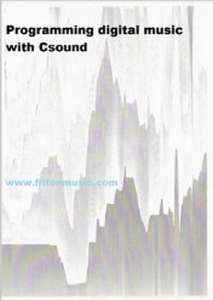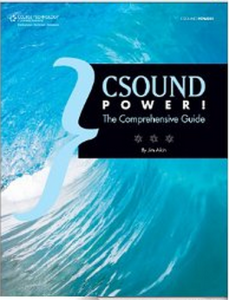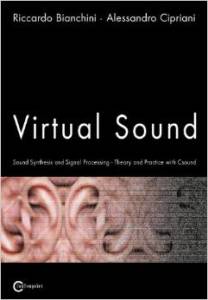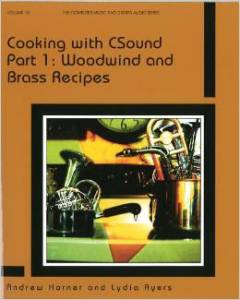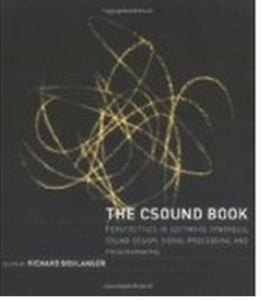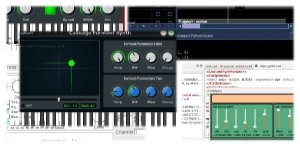
Csound Books
Click HERE to purchase the book.
http://www.zedde.com/index.php?route=product/search&filter_name=inside%20Csound
Click HERE to download a PDF of the Book.
Inside Csound – by Giorgio Zucco
—From the foreword by Dr. Richard Boulanger:
Without compare, Giorgio Zucco is one of the finest Csounders in the world. He is a supreme master of the highest degree. He is a true “sound designer” – a skill and ability that is, in fact, quite rare in our “music industry”, all chock-full with “samplers”, “remixers”, and “mashup-artists”. Giorgio Zucco has “golden ears”, and over the years he has produced an amazing “collection” of exquisite Csound instruments to prove it. I am quite confident that he could tame any machine, and make her sing the sweetest lovesongs; but what he has done instead, is to dedicate his life to the creation of some of the most beautiful, elegant, powerful, engaging, evolving, mysterious, rawcous, raw, intense, and tender musical timbres ever created in Csound.
About the Book:
Introduction to computer music, the novelty of the language Csound5, real time, envelopes, tremolo, vibrato, spatial, generative processes, control MIDI, OSC, additive synthesis, subtractive, FM, granular synthesis, physical modeling, synthesis scanned, the signal processors, construction of graphical user interfaces, integration in Max / MSP and Ableton Live, VST plugin development and much more. (In the book the author provides all the examples in the .csd format. Write to zedde@zedde.com. The samples will be sent by e-mail.)
About the Author:
Giorgio Zucco was born in Turin in 1977, graduated in composition, orchestration, electronic music at the Conservatorio “G. Verdi” in Turin, and modern guitar at the CPM of Milan. He attended a course of improvisation with Mark White and Jim Kelly of the Berklee College at Umbria Jazz. An award winning composer in various national competitions, he has carried out research in Csound and published articles in the “Csound Journal.” He works in the field of multimedia making music for commercials, documentaries and short films for RAI and LA7. From 2008 to 2012 he was assistant to support multimedia and computer music at the Conservatorio “G. Verdi” in Turin. In 2011 he was selected by the Venice Biennale to participate in the workshop with Ircam’s Emmanuel Jourdan, Grégoire Lorieux and Yan Maresz. He currently works as a sound designer for Audivation where he has created and released commercially a collection of instrument and effect plugin for Ableton Live, as part of the CsoundForLive project.
Click HERE to purchase the book.
Programming Digital Music with Csound (A Kindle Book) – by Peter Filton
A guide to creating digital music with Csound. The aim of the guide is to help you create digital music quickly and effectively at minimal cost. Csound is free software and it is a powerful language for programming music. The guide is in four chapters:
Chapter 1 describes a Csound programme and explains how it works
Chapter 2 analyses sound into its key components: amplitude, frequency and phase, and how they interact to produce a waveform
Chapter 3 covers the main techniques used to generate sound including: sampling, additive synthesis, modulation, noise, granular synthesis and physical modelling
Chapter 4 covers sound effects and sound processing techniques including: panning, amplitude processing, filtering, phasing, and delay
Csound Power!: The Comprehensive Guide – by Jim Aikin
Click HERE to purchase the book.
Csound, a free, cross-platform, do-it-yourself software solution for sound synthesis and music production, has been growing in power for more than 25 years. Getting started with this highly sophisticated system can be a bit daunting for new users. But once you’ve mastered the basic concepts, using Csound is nearly as easy as plugging patch cords into a modular synthesizer. That’s where CSOUND POWER!: THE COMPREHENSIVE GUIDE comes in. This definitive reference to Csound provides a thorough look at the most important features of this powerful program–as well as an introduction to a few secret features that even experienced Csound users may not know about. In this hands-on resource, you’ll learn how to download and install Csound, how to understand the structure of a .csd file, and how to use dozens of the most important opcodes in the program. You’ll find concise explanations, hands-on projects, and numerous code samples that will help you take advantage of Csound’s dense, feature-rich environment and make a powerful difference in your music-production workflow.
Virtual Sound – by Riccardo Bianchini & Alessandro Cipriani
Click HERE to purchase the book.
Virtual Sound is an in-depth tutorial in computer music, complete with user-friendly exercises in Csound that illustrate the theory and practice of each type of sound synthesis and processing. The subjects covered include additive synthesis, subtractive synthesis, flow-charts, control signals, vibrato and tremolo, 3-D sound, sampling, analysis and resynthesis, MIDI files and MIDI controls, amplitude and ring modulation, frequency modulation (FM), echo, reverberation, chorus, flanger, phaser, convolution, waveshaping and vector synthesis, granular synthesis, formant synthesis, and physical modeling. If you have a basic understanding of computers and the fundamentals of acoustics, you’ll have no trouble reading this book. After having read it, you should be able to use other commercial or research-oriented software with a greater understanding of how it functions.
Cooking with Csound Part 1: Woodwind and Brass Recipes – by Horner and Ayers
Click HERE to purchase the book.
Cooking with Csound offers a fresh approach to using the software to create effective sounds. This book contains a collection of software synthesis designs for the woodwind and brass instruments, which you can bake into compositional curries, casseroles and soufflés in your computer. Whether you are a composer, researcher, student or hobbyist, the ready-to-use designs found in this volume will provide you with a rich set of sounds. The designs are in the Csound software synthesis language, which is available free on the web. The book includes a tutorial for those new to Csound, and a wide variety of effects for customizing the instrument designs. A chapter on pitch representation also allows readers to use customized tunings and scales.
The Csound Book – Edited by Richard Boulanger
Click HERE to purchase the book.
Created in 1985 by Barry Vercoe, Csound is one of the most widely used software sound synthesis systems. Because it is so powerful, mastering Csound can take a good deal of time and effort. But this long-awaited guide will dramatically straighten the learning curve and enable musicians to take advantage of this rich computer technology available for creating music.
Written by the world’s leading educators, programmers, sound designers, and composers, this comprehensive guide covers both the basics of Csound and the theoretical and musical concepts necessary to use the program effectively. The thirty-two tutorial chapters cover: additive, subtractive, FM, AM, FOF, granular, wavetable, waveguide, vector, LA, and other hybrid methods; analysis and resynthesis using ADSYN, LP, and the Phase Vocoder; sample processing; mathematical and physical modeling; and digital signal processing, including room simulation and 3D modeling.
Csound: The Floss Manual – edited by Joachim Heintz and Iain McCurdy
Click HERE to download.
The goal of this manual is to provide a readable introduction to Csound. In no way is it meant as a replacement for the Canonical Csound Reference Manual. It is intended as an introduction-tutorial-reference hybrid, gathering together the most important information you will need to work with Csound in a variety of situations. In many places, links are provided to other resources, such as The Canonical Csound Reference Manual, the Csound Journal, example collections, and more.
It is not necessary to read each chapter in sequence, feel free to jump to any chapter that interests you, although bear in mind that occasionally a chapter will make reference to a previous one.
If you are new to Csound, the QUICK START chapter will be the best place to go to help you get started. BASICS provides a general introduction to key concepts about digital sound, vital to understanding how Csound deals with audio. The CSOUND LANGUAGE chapter provides greater detail about how Csound works and how to work with Csound.
SOUND SYNTHESIS introduces various methods of creating sound from scratch and SOUND MODIFICATION describes various methods of transforming sounds that already exist. SAMPLES outlines various ways you can record and play audio samples in Csound, an area that might be of particular interest to those intent on using Csound as a real-time performance instrument. The MIDI and OPEN SOUND CONTROL chapters focus on different methods of controlling Csound using external software or hardware. The final chapters introduce various front-ends that can be used to interface with the Csound engine and Csound’s communication with other applications.
If you would like to know more about a topic, and in particular about the use of any opcode, please refer first to the Canonical Csound Reference Manual.
All files – examples and audio files – can be downloaded at www.csound-tutorial.net . If you use CsoundQt, you can find all the examples in CsoundQt’s examples menu under “Floss Manual Examples”. When learning Csound (or any other programming language), you may find it beneficial to type the examples out yourself as it will help you memorise Csound’s syntax as well as how to use the opcodes. The more you get used to typing out Csound code, the more proficient you will become at integrating new techniques, as your concentration will shift from the code to the idea behind the code, and the easier it will be for you to design your own instruments and compositions.
Thanks to Alex Hofmann, this manual can be ordered as a print-on-demand at www.lulu.com. Just use the search utility there and look for “Csound”. The print version contains all content of the Csound FLOSS manual, only the hyper-links won’t work.
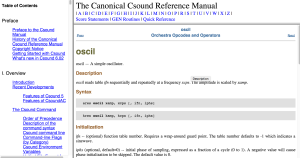
The Csound Reference Manual
Click HERE to read the manual online
Click HERE to download the manual
Csound is a unit generator-based, user-programmable computer music system. It was originally written by Barry Vercoe at the Massachusetts Institute of Technology in 1984 as the first C language version of this type of software. Since then Csound has received numerous contributions from researchers, programmers, and musicians from around the world.
Around 1991, John ffitch ported Csound to Microsoft DOS. Csound currently runs on many varieties of UNIX and Linux, Microsoft DOS and Windows, all versions of the Macintosh operating system including Mac OS X, and others.
There are newer computer music systems that have graphical patch editors (e.g. Max/MSP, PD, jMax, or Open Sound World), or that use more advanced techniques of software engineering (e.g. Nyquist or SuperCollider). Yet Csound still has the largest and most varied set of unit generators, is the best documented, runs on the most platforms, and is the easiest to extend. It is possible to compile Csound using double-precision arithmetic throughout for superior sound quality. In short, Csound must be considered one of the most powerful musical instruments ever created.
In addition to this “canonical” version of Csound and CsoundAC, there are other versions of Csound and other front ends for Csound, many of which can be found at http://csounds.com.
